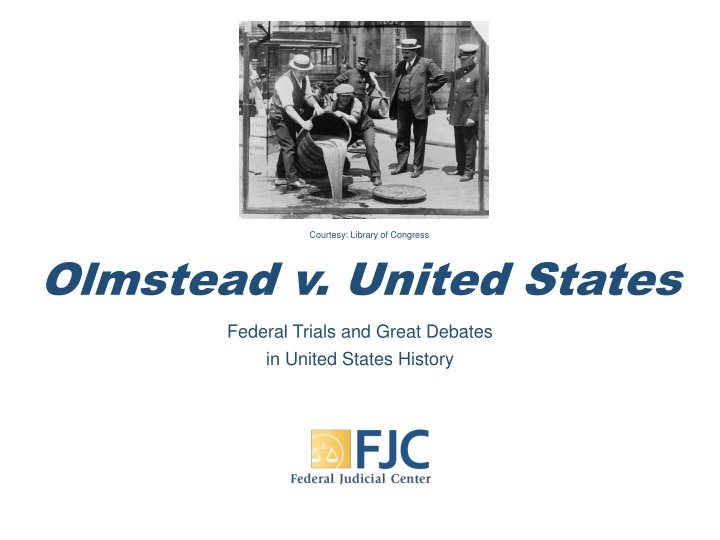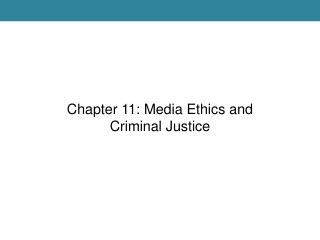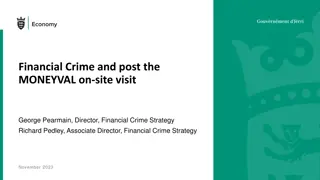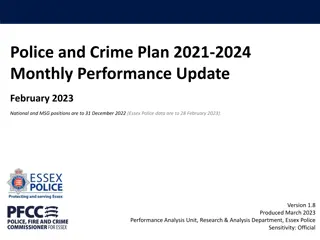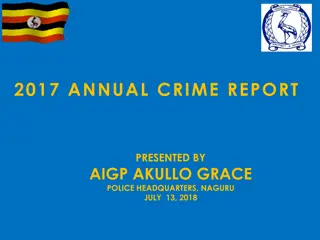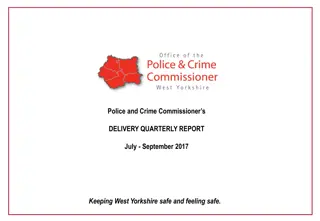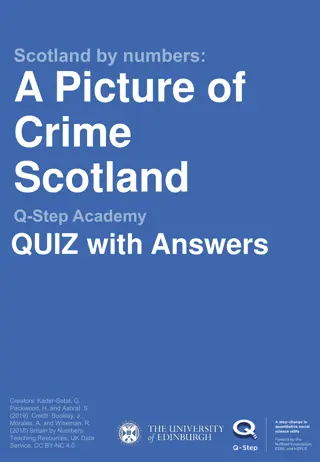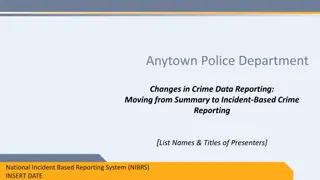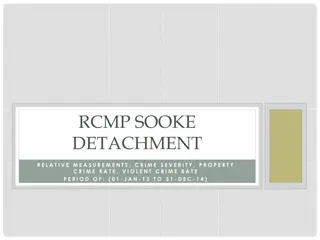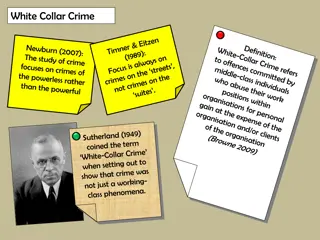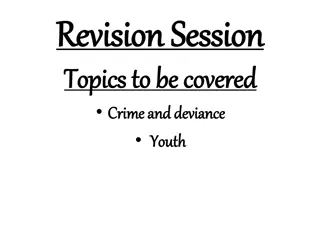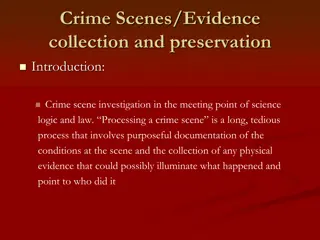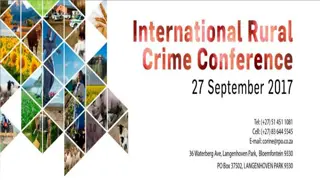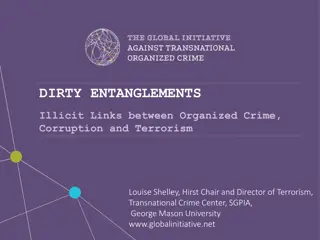National Prohibition Efforts & Rise of Organized Crime
National prohibition campaigns in the Progressive Era led to the 18th Amendment, enforcing a ban on alcohol. This resulted in increased federal workload, organized crime activities, and the rise of bootleggers like Roy Olmstead, contributing to alcohol-related violence in the US.
Download Presentation

Please find below an Image/Link to download the presentation.
The content on the website is provided AS IS for your information and personal use only. It may not be sold, licensed, or shared on other websites without obtaining consent from the author.If you encounter any issues during the download, it is possible that the publisher has removed the file from their server.
You are allowed to download the files provided on this website for personal or commercial use, subject to the condition that they are used lawfully. All files are the property of their respective owners.
The content on the website is provided AS IS for your information and personal use only. It may not be sold, licensed, or shared on other websites without obtaining consent from the author.
E N D
Presentation Transcript
Courtesy: Library of Congress Olmstead v. United States Federal Trials and Great Debates in United States History
National Prohibition Groups of social reformers sought to ban alcohol throughout the 19th and early 20th centuries. These efforts gathered momentum in the Progressive Era (circa 1890s-1920s). Progressives emphasized the social causes of problems like disease, broken homes, and crime. Alcohol was a leading cause of all these issues. A 1917 campaign for the 18th Amendment Courtesy: Library of Congress 2
National Prohibition Several states and counties prohibited alcohol in the Progressive Era. The 18th Amendment was ratified in 1919 and became effective in 1920. It banned the manufacture, sale, or transportation of intoxicating liquors nationwide. The Amendment gave the state and federal governments joint power to administer prohibition. A 1917 campaign for the 18th Amendment Courtesy: Library of Congress 3
More work for the Federal System The federal government took on most of the work of enforcing prohibition. The Volstead Act (1919) imposed federal criminal penalties for alcohol offenses. As a result, the workload of the federal courts increased rapidly over the 1920s. Federal investigators gained significantly more power. Federal criminal caseloads increased during prohibition www.fjc.gov/history 4
Organized Crime Most Americans obeyed prohibition more closely than some popular depictions suggest. However, there was still a considerable demand for illegal alcohol. This created an incentive for criminals to manufacture and sell bootlegged liquor. Alcohol-related violence was widespread in cities like Chicago. Al Capone built a crime empire around illegal alcohol Courtesy: Library of Congress 5
Roy Olmstead Roy Olmstead was one the leading bootleggers in the northwest. Olmstead was a former Seattle police officer. He left the force in disgrace after pleading guilty to a minor alcohol charge. He then built a large criminal organization. Roy Olmstead with his wife Elise Courtesy: Museum of History and Industry, Seattle Washington 6
Roy Olmstead His gang illegally imported alcohol from Canada on ships supposedly bound for Mexico. Olmstead s gang was bigger and better funded than the group of federal agents investigating him. His police contacts also helped him avoid detection and capture. Roy Olmstead with his wife Elise Courtesy: Museum of History and Industry, Seattle Washington 7
Wiretaps Federal agents wiretapped Olmstead s home and office phones to gather evidence. Wiretapping was illegal in Washington state. An informant told Olmstead about the wiretaps and offered him the transcripts of the conversations for a fee. Olmstead refused, believing such evidence would be inadmissible in court. In 1924, federal authorities arrested Olmstead and dozens of others. They used information from Canadian police in conjunction with evidence from the wiretaps. Courtesy: Library of Congress 8
The Trial Olmstead was tried in the U.S. District Court for the Western District of Washington. At trial, witnesses used the transcripts of wiretapped conversations to refresh their recollections. District Judge Jeremiah Neterer permitted the admission of records and other evidence obtained via the wiretaps. Olmstead was convicted and sentenced to four years imprisonment and an $8,000 fine. District Judge Jeremiah Neterer Courtesy: U.S. District Court for the Western District of Washington 9
Court of Appeals Olmstead appealed to the U.S. Court of Appeals for the Ninth Circuit. He argued that the use of evidence from the wiretaps violated the 4thAmendment s ban on unreasonable searches and seizures. He also argued that the use of his phone conversations violated the 5th Amendment rule against compelled self-incriminating testimony. The court ruled against Olmstead in a 2-1 opinion written by Judge William Ball Gilbert. Judge William Ball Gilbert Courtesy: Ninth Circuit U.S. Court of Appeals Library 10
Court of Appeals Judge Gilbert reasoned that the 4th Amendment prohibited the government from intruding in individuals homes. It did not protect all private conversations from detection. Judge Frank Rudkin dissented from the court s decision. He argued that both the 4th and 5th Amendments were designed to preserve a broader right to privacy. Judge William Ball Gilbert Courtesy: Ninth Circuit U.S. Court of Appeals Library 11
The Supreme Court Rules In a 5-4 decision, the Supreme Court of the United States upheld the Court of Appeals decision. Chief Justice William Howard Taft adopted a strict interpretation of the text of the 4th and 5th Amendments. The 5th Amendment, he reasoned, only applied when a defendant was compelled . . . to be a witness against himself. No one had compelled Olmstead to talk on the phone, so the 5th Amendment was not relevant. Chief Justice William Howard Taft Courtesy: Library of Congress 12
The Supreme Court Rules Most of Taft s opinion focused on the 4th Amendment. Taft noted that the Amendment mentioned the security of persons, houses, papers, and effects, but not conversations. The wiretaps did not involve a physical search of Olmstead s house, body, or belongings. Taft argued the Amendment could not be stretched to include telephone wires reaching to the whole world from [Olmstead s] house or office. Chief Justice William Howard Taft Courtesy: Library of Congress 13
Brandeis Dissents The 4 dissenting justices wrote separate opinions. The most significant of these was Justice Louis Brandeis . In 1890, Brandeis had co-written an influential article supporting a legal right to privacy. In Olmstead, he argued the 4th and 5th Amendments protected that right. Justice Louis D. Brandeis Courtesy: Library of Congress 14
Brandeis Dissents Brandeis stressed that the Constitution should be read flexibly. He argued the amendments were designed to protect broad principles, not to regulate specific conduct. The Constitution had to adapt to developments its framers could not have foreseen, including the telephone. He also argued evidence related to the wiretaps should not have been used because its collection violated state law. Justice Louis D. Brandeis Courtesy: Library of Congress 15
Aftermath and Legacy National prohibition ended with the ratification of the 21st Amendment in 1933. Brandeis view of right to privacy under the 4th and 5th Amendments laid the groundwork for many later cases. In Katz v. United States (1967), the Supreme Court overturned Olmstead. Privacy rights have played an increasingly important role in many other areas of the law, including reproductive rights. Justice Potter Stewart wrote the decision overturning Olmstead Courtesy: Library of Congress 16
